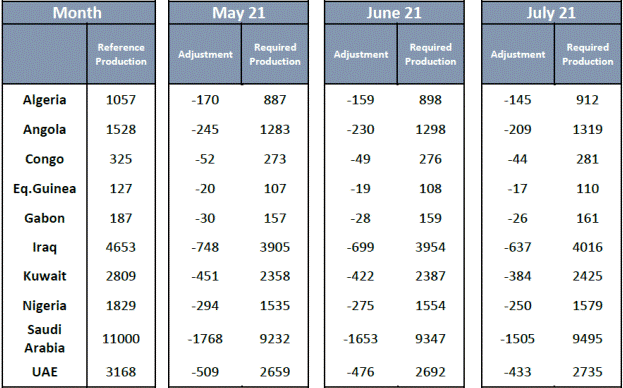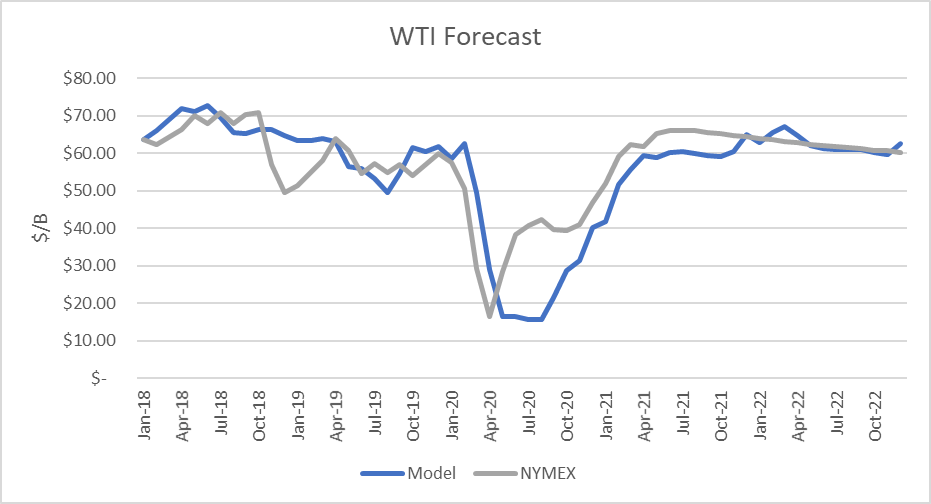The Energy Information Administration released its Short-Term Energy Outlook for May, and it shows that OECD oil inventories likely peaked at 3.210 billion in July 2020. In April 2021, it estimated stocks dropped by 26 million barrels to end at 2.897 billion, 215 million barrels lower than a year ago.
The EIA estimated global oil production at 94.04 million barrels per day (mmbd) for April, compared to global oil consumption of 96.18 mmbd. That implies an undersupply of 2.14 mmb/d or 64 million barrels for the month. That implies non-OECD stocks dropped by 33 million barrels.
For 2021, OECD inventories are now projected to draw by net 168 million barrels to 2.858 billion. For 2022 it forecasts that stocks will draw by 22 million barrels to end the year at 2.873 billion.

The EIA forecast was made incorporates the OPEC+ decision to cut production and exports. According to OPEC’s press release on April 27, 2021:
Under the referred circumstances, the Ministerial Meeting decided on the continued implementation of the production adjustment decision of the 15th OPEC and non-OPEC Ministerial Meeting (in June and July as per the attached table).”
The adjustments to the production level for May to July 2021 will be implemented as per the distribution detailed in the table below.


The EIA has assumed the following OPEC production levels for its STEO:

Oil Price Implications
I updated my linear regression between OECD oil inventories and WTI crude oil prices 2010 through 2020. As expected, there are periods where the price deviates greatly from the regression model. But overall, the model provides a reasonably high r-square result of 82 percent.

I used the model to assess WTI oil prices for the EIA forecast period through 2021 and 2022 and compared the regression equation forecast to actual NYMEX futures prices as of May 12th. The result is that oil futures prices are presently overpriced through November 2021 but then overpriced for much of the forecast horizon ending December 2022.

Uncertainties
April 2020 proved that oil prices can move dramatically based on market expectations and that they can drop far below the model’s valuations. In contrast, prices in May through April proved that the market factors in future expectations beyond current inventory levels.
In addition to the uncertainty of how deeply and how long the coronavirus will disrupt the U.S. and world oil consumption. Covid cases have spiked in India, a large oil-consuming country.

A newer issue is how fast the vaccine will be deployed in the U.S. and worldwide. The pace of deployment has been relatively slow in Europe and some countries.
Another issue is how long OPEC+ will constrain production, knowing that high prices provide an incentive to other producers, such as shale, to restore their production.
Another uncertainty is whether the U.S. will lift sanctions on Iran while rejoining the Iran nuclear deal. Biden has clearly stated that he wants the U.S. back in the deal. That could put around 1.5 more million barrels a day back into the world market or cause Saudi Arabia and others to cut production further to make room for Iran.
Conclusions
Given the recovery in oil prices, some are extrapolating further rises to $100 per barrel. The inventory forecast above clearly does not support such a rise.
The latest reports about the Iran nuclear deal is that both the U.S. and Iran want to rejoin it. However, the 2015 deal does not work for either party for the long term, so negotiations continue. No deal is imminent.
Check back to see my next post!
Best,
Robert Boslego
INO.com Contributor - Energies
Disclosure: This contributor does not own any stocks mentioned in this article. This article is the opinion of the contributor themselves. The above is a matter of opinion provided for general information purposes only and is not intended as investment advice. This contributor is not receiving compensation (other than from INO.com) for their opinion.
